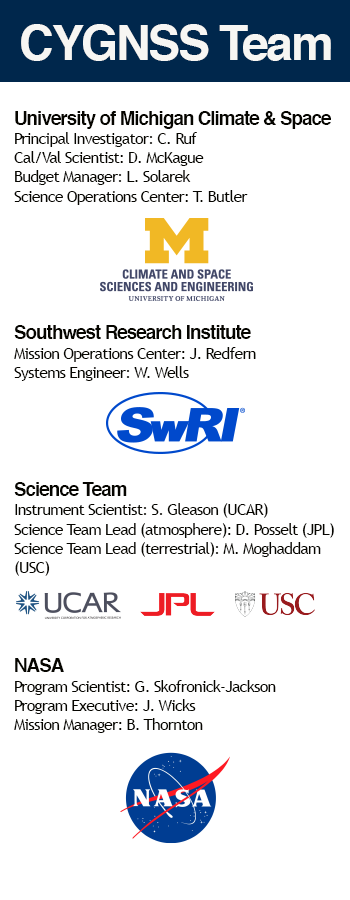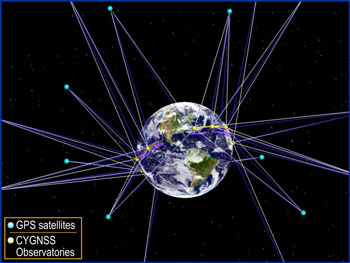CYGNSS Mission
CYGNSS launch and early orbit ops.
Discovery Canada put together this nice overview of the CYGNSS mission launch and early on-obit operations for their Mighty Planes series.
—————————————————————————————————–
Latest News
October 27, 2020
NASA extends CYGNSS mission through 2023
NASA recently completed its Senior Review process for the CYGNSS mission and we have been approved to continue science operations through 2023. Another Senior Review will occur at that time for another three-year extension. The constellation of eight spacecraft are all healthy and operating nominally in their orbits 524 km above the Earth. They continue to make 24/7 measurements of ocean surface winds, both globally and in tropical cyclones, which can be used to study meteorological processes and improve numerical weather forecasts. Over land, measurements of flood inundation and soil moisture are also continuously made, to be used in hydrological process studies and for disaster monitoring. We look forward to many more year of successful operation and scientific exploration.
For more details: https://clasp.engin.umich.edu/stories/hurricane-tracking-cygnss-satellite-system-gets-nasa-renewal-as-it-expands-its-reach/
—————————————————————————————————–
NASA’s Weather Prediction Project
The Cyclone Global Navigation Satellite System (CYGNSS) aims to improve extreme weather prediction.
CYGNSS will use a constellation of eight small satellites carried to orbit on a single launch vehicle. In orbit, CYGNSS’s eight micro-satellite observatories will receive both direct and reflected signals from Global Positioning System (GPS) satellites. The direct signals pinpoint CYGNSS observatory positions, while the reflected signals respond to ocean surface roughness, from which wind speed is retrieved.
The mission will study the relationship between ocean surface properties, moist atmospheric thermodynamics, radiation and convective dynamics to determine how a tropical cyclone forms and whether or not it will strengthen, and if so by how much. This will advance forecasting and tracking methods.
CYGNSS data will enable scientists, for the first time, to probe key air-sea interaction processes that take place near the inner core of the storms, which are rapidly changing and play large roles in the genesis and intensification of hurricanes.
The CYGNSS mission launched on December 15, 2016!
The CYGNSS mission is comprised of 8 Low Earth Orbiting (LEO) spacecraft (S/C) that receive both direct and reflected signals from GPS satellites.






